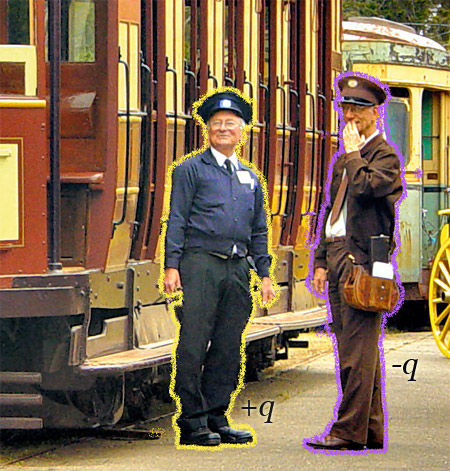Capacitors
 Imagine placing charges $+q$ and $-q$ on two adjacent conductors. What's the voltage difference between them?
Imagine placing charges $+q$ and $-q$ on two adjacent conductors. What's the voltage difference between them?
Capacitance
 Imagine placing charges $+q$ and $-q$ on two adjacent conductors. What's the voltage difference between them?
Imagine placing charges $+q$ and $-q$ on two adjacent conductors. What's the voltage difference between them?
Since each one is a conductor, the potential on each one is everywhere the same, though different from the other one.
We can integrate the electric field along a path between them to find the potential difference, $V$ (which we really ought to write as $\Delta V$, but will follow conventions and write as just "V" instead): $$V = V_+-V_- = \int_-^+ \myv E \cdot d \myv l.$$
- consists of two flat, rectangular, conducting plates.
- The two plates are separated by a distance, $d$.
- Each plate has an area, $A$, where $A\gg d^2$.
- Charging up the capacitor means, one plate has a total charge $+Q$ and the other one has a total charge $-Q$.
- Assume equal and opposite charges on two surfaces.
- Calculate $\myv E$, (for example, in problem 2.36, using Gauss' law).
- Use "$V$"=$\Delta V=-\int_-^+ \myv E\cdot d\myv l=+\int_+^- \myv E\cdot d\myv l$.
- $C=q/V$.
Since $$\myv E =\frac{1}{4 \pi \epsilon_0}\int \frac{\rho}{\rr^2}\uv \rr\, d \tau,$$ it seems that doubling the charge doubles the potential difference, that is, that the following ratio is a constant:
$$\frac{q}{V} \equiv C.$$ $C$, the "capacitance", is a constant which depends on the geometry of the arrangement of the conductors, but not on the charge per se.
$C$ has units of coulombs / volt = farads (F).
Since the work to move an object with small charge $dq$ from potential 1 to potential 2, is $dq (V_1-V_2)$: $$dW = dq V =dq \frac{q}{C},$$
The work needed to "charge up" a capacitor from 0 to total charge $q$ is: $$W=\int_0^q \frac{q'}{C}dq' = \frac{1}{2}\frac{q^2}{C} = \frac{1}{2}CV^2.$$
Example Derive the capacitance of a flat-plate capacitor:
assuming (only slight approximation) that the field between plates is uniform, and zero everywhere else...
We still have the same discontinuity in the electric field above and below any surface charge density: $$ E_{\perp}^{\text{above}} - E_{\perp}^{\text{below}}=\sigma / \epsilon_0.$$
But if the surface below the boundary is a conductor, then $\myv E_\text{below}=0$, and so the field above must be $\sigma/\epsilon_0$ (twice the field on either side of an infinite sheet of charge).
The answer is $C=A\epsilon_0/d$.
Summary
One way to calculate capacitance is: